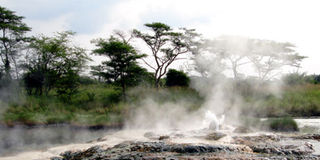Prime
Uganda’s love - hate affair with Geothermal energy

Five years back, seven companies received licences to explore geothermal energy. This figure has dropped to only three. Courtesy photo
Uganda’s electricity regulator is prone to hailing the energy generation mix. Simply put, the generation mix includes the availability of different sources of power such as hydro energy, thermal, solar and wind among others, to ensure power reliability.
But Uganda currently has no geothermal power. Power that is said to be cheaper than most of the country’s sources. Investors interested come and go without doing much.
In fact, government is looking for a development partner to aid its development costs to boost production.
“We are looking for a development partner to support us with the development costs,” Ms Ziria Tibalwa, chief executive officer Electricity Regulatory Authority (ERA) says.
Development costs, she says, involve exploration and drilling which do not come cheap.
Investment
Five years back, seven companies received licences to explore geothermal energy. This figure has dropped to only three.
Currently, Gids Consult Limited holds the licence to Buranga in Bundibugyo which is currently drilling while Ihimbo in Rukungiri is held by Moto geothermal project Limited at the surface exploration stage.
Panyigoro sits with Bantu Energy Uganda Limited which has only started with the surface exploration.
While studies put the cost of geothermal power between 5 and 10 cents, which is cheaper than solar and some hydro plants, Mr Godfrey Bahati, commissioner Geothermal resources department, directorate of geology survey and mines, says the cost depends on different factors.
“If the area is hilly, you definitely have a higher price because you have to build escarpments, roads, while if the land is flat, it is easier hence cheaper,” he explains.
He added that the behaviour of the resource underground also matters.
Uganda has 24 sites with potential to produce about 1,500 megawatts of geothermal energy.
Untapped sources
The Rift Valley of East Africa and western coast of South America are named as the greatest untapped sources of geothermal energy.
Studies have been undertaken in different areas. Bundibugyo, Kibiro, Panyimur and Buranga among others bear exploration potential.
However, no fruition has been seen for decades in this sphere.
In such times where climate and the ecosystem are high on the watch list, geothermal – a very clean source of energy – is key.
Expensive venture
However, generation of this power is not as affordable as it is to the environment.
Minister of Energy and Mineral development Irene Muloni explained that geothermal energy is good renewable energy but government will always go in for the cheapest alternative.
“Hydro power,” she said.
Worries surrounding generation of geothermal power stem from the geological risk associated with exploration.
“The worry is I will inject so much and supposing I find little steam?” she pondered.
She is reiterated by Uganda Investment Authority whose interactions with investors has revealed that capital and development costs required to produce geothermal are huge.
Investors are also keen on government’s commitment to build infrastructure required to evacuate the power for use.
“Accessing funding for investment in this is not easy, once the required infrastructure is in place, I want to believe it would be cheaper,” Ms Sheila Karungi, UIA director investment promotion and business development said.
Kenya’s story
Daily Monitor’s sister paper, Business Daily last year reported that Kenya was ranked ninth globally in geothermal power generating capacity and number one in Africa with 700MW.
The East African country came after some countries such as the United States and Philippines with 2500MW and 1,900MW respectively.
Way forward
According to Mr Bahati, the onus is on government to carry out feasibility studies and exploration to attract private sector development.
Once areas with geothermal energy capacity are mapped out, he says it will be easier to attract investment in this sphere.
How Geothermal energy is created
Geothermal energy is energy produced or generated using the heat or steam from the earth’s surface.
According to a study from National Association of Professional Environmentalists (NAPE), geothermal energy is produced from the earth’s inner core, where temperatures can heat up to 4,245 degrees.
A high enough temperature heats up mantle tock to form magma which also heats up other rocks, eventually generating water.
When the water finds its way to the earth’s surface, it forms hot springs or geysers.




